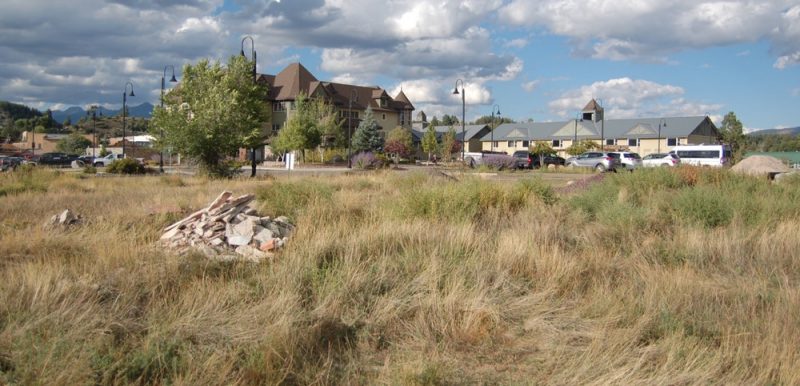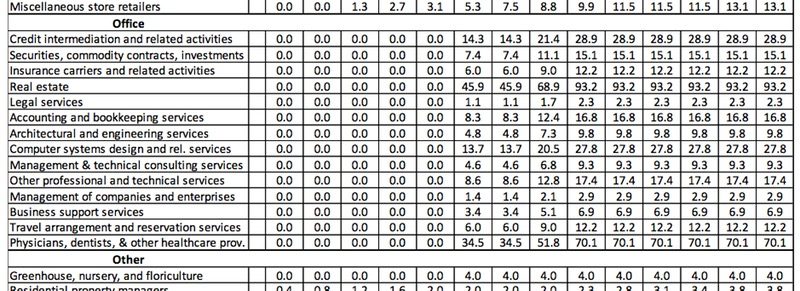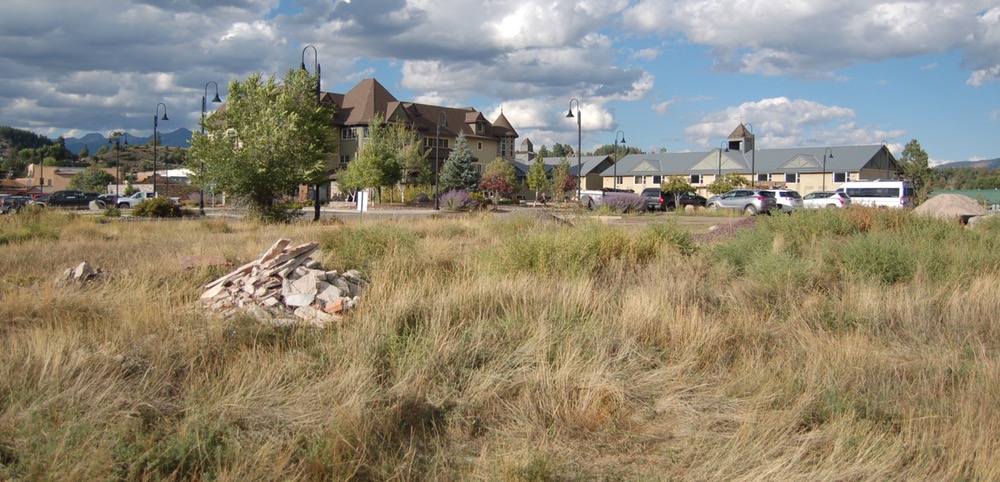… a pocket full of mumbles, such are promises,
All lies and jest, still a man hears what he wants to hear,
And disregards the rest…
— ‘The Boxer’ by Paul Simon
For those who wanted to hear that millions of dollars in Tax Increment Financing (TIF) incentives would create a virtual economic revolution in downtown Pagosa Springs over the next 15 years or so… there was plenty to get excited about, at the Wednesday, September 11 ‘Urban Renewal Authority’ presentation… hosted by developer David Dronet at the Springs Resort conference room. Not only would a Town-approved TIF generate new streets and utilities on 27 vacant acres of travertine rock, but those streets would quickly become lined with hotels, stores, restaurants, offices, single family homes, town homes and multi-family condo complexes.
Finally, hundreds of busy new buildings in the heart of our historical downtown, on a property where previous developers have consistently failed to make their dreams come true. Plus, we were assured that the vibrant economic activity would spill over into the rest of our community, generating hundreds of new, high-paying jobs all around town.
If this was what you wanted to hear, Mr. Dronet did a truly impressive job of selling you some promises. In my 25 years in Pagosa, I can’t recall witnessing such an intelligent, well-prepared storytelling session. Even Fred Schmidt, the long-time President of the San Juan Water Conservancy District who sold us the Dry Gulch Reservoir, never came close.
And I sensed, that evening, that it was a story many people in the audience wanted to hear… a story about a thriving new neighborhood… in a downtown that has struggled to grow any new commercial structures since the late 1990s. Yes, we did get a Walmart, and a Tractor Supply, and a General Dollar, and an impressive new Medical Center… uptown. But none of these were built in our historical downtown, where the Town Council members meet at least twice a month to discuss our community’s growth, or lack thereof.
Mr. Dronet provided an uplifting vision of a prosperous future.
And this editorial series? “Are Tax Breaks Making Colorado Broke?” This is another story, different from Mr. Dronet’s story. We are both telling stories about a possible future — a future where taxpayers continue to hand out millions of ‘incentive’ dollars to wealthy corporations, as Colorado has been doing for at least the past 40 years — or where we say to our elected leaders, “Enough is enough.”
Some of our readers may have downloaded the ‘Economic Impact’ report created for the Springs Resort by consultant Mike Anderson. (If you haven’t, you can download it here.) Mr. Anderson provided us with a multitude of charts that supposedly justify $79.7 million in future taxes redirected away from ordinary public services, to pay back the developers for new streets and infrastructure installed on 27 acres adjacent to the Springs Resort.
There’s no doubt this redirection of tax revenues would greatly benefit the developers, who have made it abundantly clear they will not pursue development on the “blighted” property without the creation of an ‘urban renewal’ Tax Increment Financing mechanism by the Town Council.

I find it curious, however, that Mr. Anderson did not include in his 73-page report any evidence that Pagosa Springs actually has a demand for the hundreds of buildings and hundreds of additional jobs shown in the “Economic Impact” report. Especially, perhaps, the report provides no evidence that — within ten years — the jobs created by this TIF scheme would pay an average of $46,750 a year. I was curious how Mr. Anderson came up with such a generous average wage for people who would be working in Pagosa’s generally low-paid hospitality-tourism industry.
So I looked again at the chart on ‘page 5’ titled “Projected On-Site (Direct) Employment (Full-Time Equivalent Jobs)”.
Mr. Anderson has proposed that Mr. Dronet’s TIF scheme will result in the construction of 40,600 square feet of “Office.” To put that size building into perspective, the Pagosa Springs High School — with its enormous commons area, a 400-seat auditorium, a full-size basketball gym, band room, weight room, offices and dozens of classrooms — measures about 118,000 square feet. Our Walmart store measures about 98,000 square feet.
Who, exactly, will be working in 40,600 square feet of shiny new offices?

A surprising number of professionals will be making these ‘Urban Renewal Area’ offices their chosen place of work.
- 70 “Physicians, dentists & other healthcare providers”
- 93 “Real estate” professionals
- 29 “Credit intermediation” professionals
- 28 “Computer design” professionals
- 15 “Securities & investment” professionals
- 17 “Accounting & bookkeeping” professionals
And dozens of other consultants and professionals. A total of 325 highly-paid professionals? No wonder Mr. Anderson had concluded, in his economic impact projection, that the average wage would be twice what a typical tourism industry worker earns.
Our regular Daily Post readers are aware that my editorials often express concern for our working families, who are slowly being priced out of Pagosa by various market forces and government policies. So I was very interested in the conclusions reached by researchers Tony Robinson and Chris Nevitt, when they studied the economic effects of TIF-funded ‘urban renewal’ projects in Denver — the home to 53 ‘urban renewal’ projects — between 1995 and 2005.
Here are some of their conclusions in Part Three of their impressive 123-page study, Are We Getting Our Money’s Worth?:
Jobs at TIF-Subsidized Projects Pay Wages Below Denver’s Average, Even for Similar Occupations
Contrary to the ostensible purpose of publicly-subsidized economic development, TIF-subsidized projects may be exacerbating the growing problem of low-wage/low-benefit employment in Denver. Wage surveys at three signature TIF- projects reveal that jobs there pay substantially less than Denver average wages, and 14%-27% less even than average wages for comparable occupational categories. In short, these TIF projects are expanding the low-wage/low-benefit sector of Denver employment.
Wages at TIF Subsidized Projects Fall Short of Family Self- Sufficiency, Imposing Hardship on Workers and Costs on the Public
Wages at the three major TIF-subsidized projects examined in the study are so low as to leave most workers’ families unable to provide for basic family needs on their own. At these three projects alone, the estimated “self-sufficiency deficit” amounts to almost $23 million a year. This results either in personal family hardship – extra jobs taking time away from family and community activity, skipped meals, missed payments of bills, unsupervised children – or costs imposed on publicly-funded assistance…
Employees at TIF-Subsidized Projects face Unaffordable Housing Burdens and the Housing Mix at TIF-Subsidized Projects Does Not Serve Most Denver Residents
Contrary to the ostensible purpose of publicly-subsidized economic development, TIF-subsidized projects are exacerbating the housing affordability crisis in Denver. First, because of the low wage structure at TIF-projects, well over half of employees at TIF sites are estimated by HUD standards to face unaffordable rent burdens (paying more than one-third of income on housing). More broadly, housing created at TIF-subsidized projects is overwhelmingly high end and unaffordable to average Denver families…
About halfway through his September 11 presentation, Mr. Dronet was talking about the mix of housing types proposed for the vacant land adjacent to the Springs Resort. He noted that the plans include multi-family condos or apartments.. and some might become rental units… but it’s unlikely they would be “affordable.”
Mr. Dronet: “It’s going to be tough to get a single family home or a townhouse to be at a price point that’s less than $350,000 or $450,000. That’s… I just don’t see how it pencils. The math doesn’t work.”
We might wonder about that price point: $450,000. Do we want to promote — via tax subsidies — the conversion of downtown Pagosa Springs into another Aspen or Telluride? Probably not.
Is that what Mr. Dronet, and the owner of the 27 acres, Jack Searle, are essentially asking us to do?

